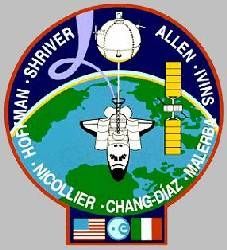
Home - Search - Browse - Alphabetic Index: 0- 1- 2- 3- 4- 5- 6- 7- 8- 9
A- B- C- D- E- F- G- H- I- J- K- L- M- N- O- P- Q- R- S- T- U- V- W- X- Y- Z
STS-46
 STS-46 Credit: www.spacefacts.de |
AKA: Atlantis. Launched: 1992-07-31. Returned: 1992-08-08. Number crew: 7 . Duration: 7.97 days.
Payloads: Tethered Satellite System (TSS)-1; European Retrievable Carrier (EURECA)-1L; Evaluation of Oxygen Integration with Materials (EOIM)-III/ Thermal Energy Management Processes (TEMP)-2A; Consortium for Materials Development In Space Complex Autonomous Payloads (CONCAP)-II and Ill; IMAX Cargo Bay Camera (ICBC); Limited Duration Space Environment Candidate Materials Exposure (LDCE); Pituitary Growth Hormone Cell Function (PHCF); Ultraviolet Plume Instrument (UVPI).
Orbits of Earth: 127. Distance traveled: 5,344,642 km. Orbiter Liftoff Mass: 116,133 kg. Orbiter Mass at Landing: 94,711 kg. Payload to Orbit: 12,965 kg. Payload Returned: 8,434 kg. Landed at: Runway 33 at Kennedy Space Center, Florida. Landing Speed: 378 kph. Touchdown miss distance: 594 m. Landing Rollout: 3,310 m.
NASA Official Mission Narrative
Mission Name: STS-46 (49)
Atlantis (12)
Pad 39-B (20)
49th Shuttle Mission
12th Flight of OV-104
KSC Landing (11)
Crew:
Loren J. Shriver (3), Commander
Andrew M. Allen (1), Pilot
Jeffrey A. Hoffman (3), Mission Specialist 1
Franklin R. Chang-Diaz (3), Mission Specialist 2
Claude Nicollier (1), Mission Specialist 3
Marsha S. Ivins (2), Mission Specialist 4
Franco Malerba (1), Payload Specialist 1
Milestones:
OPF1 - 4/2/92
VAB - 6/4/92
PAD - 6/11/92
Payload:
TSS-1,EURECA-II,LDCE,PHCF,UVPI,IMAX-06,EOIM-III/TEMP-2A,CONCAP-II,ICBC,
AMOS
Mission Objectives:
Launch: July 31, 1992, 9:56:48 a.m. EDT. Launch Weight: 256,031 lbs.
Orbit:
Altitude: 230 nm
Inclination: 28.45 degrees
Orbits: 127
Duration: 7 days, 23 hours, 15 minutes, 3 seconds.
Distance: 3,321,007 miles
Hardware:
SRB: BI-052
SRM: 360W/L025
ET : 50/LWT-43
MLP : 1
SSME-1: SN-2032
SSME-2: SN-2033
SSME-3: SN-2027
Landing:
August 8, 1992, 9:11:50 a.m. EDT, Runway 33, Kennedy Space Center. Rollout distance: 10,860 feet. Mission extended one day to complete scientific objectives. Landing Weight: 208,806 lbs.
Mission Highlights:
Mission's primary objectives were the deployment of ESA's European Retrievable Carrier (EURECA) and the joint NASA/Italian Space Agency Tethered Satellite System (TSS). EURECA was deployed a day later than scheduled because of a problem with its data handling system. Seven and a half hours after deployment, the spacecraft's thrusters were fired to boost EURECA to its planned operating altitude of around 31O miles. However, thruster firing was cut to six minutes from 24 minutes because of unexpected attitude data from the spacecraft. The problem was resolved and EURECA was successfully boosted to its operational orbit on the mission's sixth day. TSS deployment also was delayed one day because of the problems with EURECA. During deployement, the satellite reached a maximum distance of only 86O feet from the orbiter instead of the planned 12.5 miles because of a jammed tether line. After numerous attempts over several days to free the tether, TSS operations were curtailed and the satellite was stowed for return to Earth. Seconday payloads included: Evaluation of Oxygen Integration with Materials/Thermal Management Processes (EOIM-III/TEMP 2A), Consortium for Materials Development in Space Complex Autonomous Payload (CONCAP II and CONCAP III), IMAX Cargo Bay Camera (ICBC), Limited Duration Space Environment Candidate Materials Exposure (LDCE), Air Force Maui Optical Site (AMOS), Pituitary Growth Hormone Cell Function (PHCF), and Ultraviolet Plume Instrument (UVPI). Mission extended extra day to complete scientific objectives.
More at: STS-46.
Family: Manned spaceflight. People: Allen, Andy, Chang-Diaz, Hoffman, Ivins, Malerba, Nicollier, Shriver. Country: USA. Spacecraft: Atlantis. Projects: STS. Launch Sites: Cape Canaveral. Agency: NASA, NASA Houston.
1992 July 31 - . 13:56 GMT - . Launch Site: Cape Canaveral. Launch Complex: Cape Canaveral LC39B. Launch Platform: MLP1. LV Family: Shuttle. Launch Vehicle: Space Shuttle.
- STS-46 - .
Call Sign: Atlantis. Crew: Allen, Andy,
Chang-Diaz,
Hoffman,
Ivins,
Malerba,
Nicollier,
Shriver.
Payload: Atlantis F12 / Eureca 1 / TSS 1. Mass: 12,965 kg (28,582 lb). Nation: USA.
Related Persons: Allen, Andy,
Chang-Diaz,
Hoffman,
Ivins,
Malerba,
Nicollier,
Shriver.
Agency: NASA Houston.
Program: STS.
Class: Manned.
Type: Manned spaceplane. Flight: STS-46.
Spacecraft Bus: Shuttle.
Spacecraft: Atlantis.
Duration: 7.97 days. Decay Date: 1992-08-08 . USAF Sat Cat: 22064 . COSPAR: 1992-049A. Apogee: 437 km (271 mi). Perigee: 425 km (264 mi). Inclination: 28.50 deg. Period: 93.20 min.
Manned seven crew. Deployed Eureca-1; failed to deploy Italian tether probe TSS-1. Payloads: Tethered Satellite System (TSS)-1; European Retrievable Carrier (EURECA)-1L; Evaluation of Oxygen Integration with Materials (EOlM)-lll/ Thermal Energy Management Processes (TEMP)-2A; Consortium for Materials Development In Space Complex Autonomous Payloads (CONCAP)-ll and Ill; IMAX Cargo Bay Camera (ICBC); Limited Duration Space Environment Candidate Materials Exposure (LDCE); Pituitary Growth Hormone Cell Function (PHCF); Ultravio-let Plume Instrument (UVPl).
1992 August 8 - .
- Landing of STS-46 - . Return Crew: Allen, Andy, Chang-Diaz, Hoffman, Ivins, Malerba, Nicollier, Shriver. Nation: USA. Related Persons: Allen, Andy, Chang-Diaz, Hoffman, Ivins, Malerba, Nicollier, Shriver. Program: STS. Flight: STS-46. STS-46 landed at 13:13 GMT. .
Back to top of page
Home - Search - Browse - Alphabetic Index: 0- 1- 2- 3- 4- 5- 6- 7- 8- 9
A- B- C- D- E- F- G- H- I- J- K- L- M- N- O- P- Q- R- S- T- U- V- W- X- Y- Z
© 1997-2019 Mark Wade - Contact
© / Conditions for Use